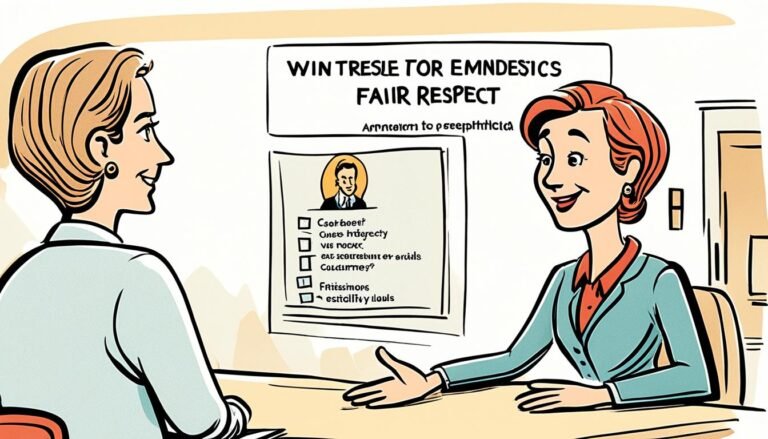Understanding Buyer Behavior: The Decision-Making Process
Ever wondered what makes people buy things? Knowing how consumers decide to buy is key to great marketing. It’s not just about the sale itself, but the whole journey before it shapes their choices.
For businesses, understanding consumer psychology is a big deal. It helps improve the customer experience and boost profits. This is super important online, where lots of data helps shape better sales strategies.
Key Takeaways
- The consumer decision-making process involves multiple stages, including problem recognition, information search, evaluation of alternatives, purchase decision, and post-purchase evaluation.
- Psychological, social, and cultural factors significantly influence consumer behavior and purchasing decisions.
- Effective marketing communication across various channels can shape consumer perceptions, preferences, and buying decisions.
- Consumer segmentation and personalization are crucial for targeting specific customer segments.
- Digital technologies have transformed the shopping experience, providing valuable data to optimize the customer journey.
The Essence of Consumer Decision Making
The way people make buying choices is key to understanding consumer decision making. It includes steps like identifying needs, gathering info, comparing options, making a purchase, and checking satisfaction later. Knowing this helps businesses market better.
What Is the Consumer Decision Making Process?
This process is a detailed journey with several stages. It’s also known as the buyer journey, buying cycle, buyer funnel, and consumer purchase decision process. The main parts stay the same, no matter the name.
The 5 Stages of the Consumer Decision Making Process
- Need Recognition (Awareness): The consumer notices a need or problem that needs solving.
- Information Search (Research): The consumer looks for info from various sources to help their decision.
- Evaluation of Alternatives (Consideration): The consumer checks out different options to see which fits best.
- Purchase Decision (Conversion): The consumer decides and buys the product or service.
- Post-Purchase Evaluation (Re-purchase): The consumer checks how happy they are with the buy and if they’ll buy it again.
Knowing the details of how people decide what to buy is key for businesses. It helps them market better, predict what customers will do, and increase sales and loyalty.
“The consumer decision-making process is a complex, multifaceted journey that ultimately shapes the purchasing decisions of individuals.”
Need Recognition: The Starting Point
The journey of making a purchase starts with noticing a need. This need can come from internal stimuli, like feeling hungry or sad, or external stimuli, like seeing an ad or smelling food. Almost every buy is driven by either physiological or emotional needs.
When buying expensive, long-lasting items, the decision-making gets complex. In these cases, the process can have up to six stages. Need recognition is the key first step.
- Marketing efforts help spark problem recognition and shape how people see their needs.
- People look for info from family, friends, online, reviews, salespeople, and their own experiences during the info search stage.
- Choosing between options depends on factors like price, quality, ease, and other details relevant to the purchase.
“Understanding what consumers look for is key for marketers to make sure their products are considered.”
By understanding the need behind consumer actions, companies can make their offerings and marketing more relevant. This first step is crucial for the rest of the decision-making process.
Information Search: Guiding the Research
When a consumer feels the need for something, they start looking for solutions. Businesses should be ready to help them. They usually begin by searching on search engines like Google for the best products or services.
How much info a customer needs to find depends on their knowledge and the complexity of choices. By making sure their online store is easy to find and their product pages are clear, businesses can catch the consumer’s eye during this key information search stage.
Strategies to Optimize During the Research Stage
To help consumers in their consumer research, businesses can try these strategies:
- Do keyword optimization to find and use the search terms potential customers are looking for.
- Make content that answers the specific needs and questions of their audience.
- Encourage user-generated reviews to build trust and credibility, which can sway buying decisions.
- Use SEO tips to make their website and product pages more visible on search engines.
By using these strategies, businesses can be seen as valuable resources during the information search stage. This helps guide consumers to make a purchase.
“Consumers generally start their research on Google, looking for information like ‘best cameras 2020’ or ‘top-rated cameras’.”
Evaluating Alternatives and Making the Purchase
When customers are close to buying something, they look at all their options. They think about objective factors like price and features. They also consider subjective factors like how they feel about a brand.
Businesses can help at this key stage. They can use user-generated content and customer reviews. This can make customers more engaged, build brand trust, and show them why their product is the best choice.
- Customers look at different products to see which one fits their needs best. They check things like price, benefits, and if it’s easy to get.
- Ads should show why the product is better than others. They should explain its special benefits.
- After looking at all the info, customers should make a smart choice about what to buy.
“Using reviews and content from users on websites can make customers more engaged, build trust, and lower the chance they’ll leave the site.”
By adding user-generated content and customer reviews online, companies can make shopping better for customers. This helps them stand out and affects how customers decide what to buy.
Conclusion
In today’s fast-changing world, knowing how customers make decisions is key for businesses to succeed. By looking into the steps of need recognition, information search, alternative evaluation, and the final purchase decision, companies can learn a lot. This knowledge helps shape their marketing and sales plans.
Tools like customer journey mapping, empathy analysis, and user personas help businesses see things from their customers’ point of view. They can guess what customers think, feel, and do at every step. This way, companies can shape the outcome in their favor and meet the changing needs of their customers.
Understanding consumer behavior, the buyer journey, and how customers make decisions gives businesses the edge they need. It helps them improve the customer experience and grow over time. By using this deep understanding, companies can move forward with confidence in today’s market. They can offer value that really speaks to today’s careful consumers.
Source Links
- Buyer Behaviour And Decision-Making Process
- Buyer Behavior | OpenStax Intro to Business
- Marketing & Buyer Behaviour – the Decision-Making Process
- Chapter 6. Consumer Buying Behavior Notes
- Consumer Decision Making Process
- How the Consumer Decision Making Process Influences Buying Choices
- Reading: Buying-Process Stages | Principles of Marketing
- 5 Stages of the consumer buying decision process – Imagine Hub
- Information Search and Decision Making
- The Consumer Decision Making Process: Theories, Models & Tools
- Definition and Examples of the Consumer Decision-Making Process
- Understanding the Consumer Decision Making Process | Yotpo
- Understanding consumer behavior to influence the decision-making process
- 5 Important Stages of the Consumer Decision Making Process







